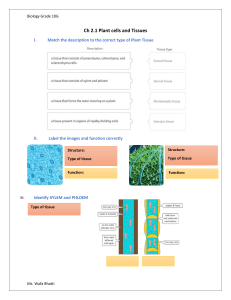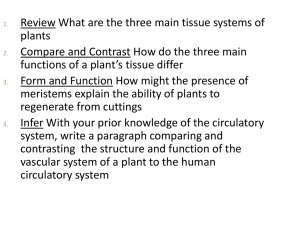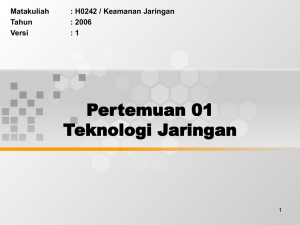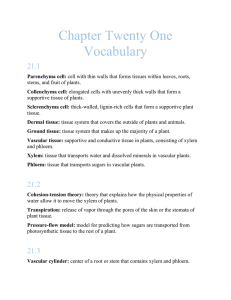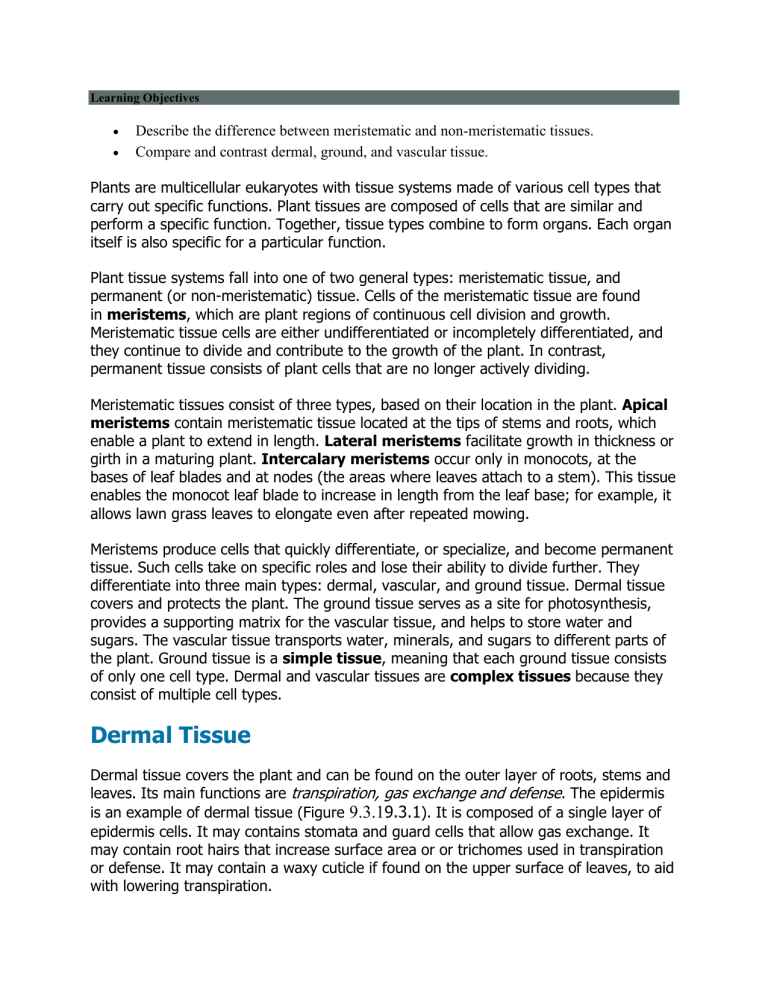
Learning Objectives Describe the difference between meristematic and non-meristematic tissues. Compare and contrast dermal, ground, and vascular tissue. Plants are multicellular eukaryotes with tissue systems made of various cell types that carry out specific functions. Plant tissues are composed of cells that are similar and perform a specific function. Together, tissue types combine to form organs. Each organ itself is also specific for a particular function. Plant tissue systems fall into one of two general types: meristematic tissue, and permanent (or non-meristematic) tissue. Cells of the meristematic tissue are found in meristems, which are plant regions of continuous cell division and growth. Meristematic tissue cells are either undifferentiated or incompletely differentiated, and they continue to divide and contribute to the growth of the plant. In contrast, permanent tissue consists of plant cells that are no longer actively dividing. Meristematic tissues consist of three types, based on their location in the plant. Apical meristems contain meristematic tissue located at the tips of stems and roots, which enable a plant to extend in length. Lateral meristems facilitate growth in thickness or girth in a maturing plant. Intercalary meristems occur only in monocots, at the bases of leaf blades and at nodes (the areas where leaves attach to a stem). This tissue enables the monocot leaf blade to increase in length from the leaf base; for example, it allows lawn grass leaves to elongate even after repeated mowing. Meristems produce cells that quickly differentiate, or specialize, and become permanent tissue. Such cells take on specific roles and lose their ability to divide further. They differentiate into three main types: dermal, vascular, and ground tissue. Dermal tissue covers and protects the plant. The ground tissue serves as a site for photosynthesis, provides a supporting matrix for the vascular tissue, and helps to store water and sugars. The vascular tissue transports water, minerals, and sugars to different parts of the plant. Ground tissue is a simple tissue, meaning that each ground tissue consists of only one cell type. Dermal and vascular tissues are complex tissues because they consist of multiple cell types. Dermal Tissue Dermal tissue covers the plant and can be found on the outer layer of roots, stems and leaves. Its main functions are transpiration, gas exchange and defense. The epidermis is an example of dermal tissue (Figure 9.3.19.3.1). It is composed of a single layer of epidermis cells. It may contains stomata and guard cells that allow gas exchange. It may contain root hairs that increase surface area or or trichomes used in transpiration or defense. It may contain a waxy cuticle if found on the upper surface of leaves, to aid with lowering transpiration. Figure 9.3.19.3.1: Openings called stomata (singular: stoma) allow a plant to take up carbon dioxide and release oxygen and water vapor. The (a) colorized scanningelectron micrograph shows a closed stoma of a eudicot. Each stoma is flanked by two guard cells that regulate its (b) opening and closing. The guard cells are more curved when the stoma is open compared to when it is closed. The (c) guard cells sit within the layer of epidermal cells (credit a: modification of work by Louisa Howard, Rippel Electron Microscope Facility, Dartmouth College; credit b: modification of work by June Kwak, University of Maryland; scale-bar data from Matt Russell) In woody plants, the epidermis breaks apart into a thick periderm as secondary growth allows the plant to grow in girth. The cork cambium, which makes cork cells, the cork cells (which are dead at maturity), and the phelloderm (parenchyma cells on the inside of the cork cambium) together make up the periderm (Figure 9.3.29.3.2). The periderm functions as the first line of defense for the plant, protecting it from fire or heat injury, dehydration, freezing conditions, and/or disease. Figure 9.3.29.3.2: Cross section of a woody stem. The periderm is composed of the cork cambium, cork cells, and phelloderm. Credit: Kammy Algiers (CC-BY). Ground Tissue Often times, tissues that are not considered dermal or vascular tissue are noted as ground tissue. These cells store molecules (such as starch), photosynthesize (such as mesophyll cells), or support the plant. There are three types of ground tissue: collenchyma, sclerenchyma, and parenchyma. Collenchyma (Figures 9.3.3−49.3.3−4) is living supportive tissue that has elongated cells and an unevenly thickened primary cell wall. Its main function is the mechanical support of young stems and leaves via turgor. Figure 9.3.39.3.3: Collenchyma cell walls are uneven in thickness, as seen in this light micrograph. They provide support to plant structures. (credit: modification of work by Carl Szczerski; scale-bar data from Matt Russell) Sclerenchyma is a dead supportive tissue that consists of long sclerenchyma fibers (Figure 9.3.49.3.4) or short, crystal-like cells (sclereids; Figure 9.3.59.3.5). Sclerenchyma fibers occur in groups (bundles). Sclereids may be branched or not and occur individually or in small clusters. Each cell has a uniformly thick secondary wall that is rich in lignin. Its main function is a support of older plant organs, and also hardening different parts of plants (for example, make fruit inedible before ripeness so no one will take the fruit before seeds are ready to be distributed). Without sclerenchyma, if a plant isn’t watered, the leaves will droop because the vacuoles will decrease in size which lowers the turgor. Fibers inside phloem (see below) are sometimes regarded as a separate sclerenchyma. Figure 9.3.49.3.4: Left to right, top to bottom: parenchyma, sclerenchyma (cross- and longitudinal sections) and collenchyma. First three photos from the stem of Helianthus, fourth from Medicago stem. Magnification ×400. Figure 9.3.59.3.5: The grainy texture of pears (Pyrus) is due to clusters of stone cells (sclereids), the thick-walled cells that stained pink (left, magnification = 400X). Water lily (Nymphea) leaves contains single, branched sclereids (right, magnification = 400X). Left and right image by Berkshire Community College Bioscience Image Library (public domain). Parenchyma (Figure 9.3.49.3.4) are spherical, elongated cells with a thin primary cell wall. It is a main component of young plant organs. The basic functions of parenchyma are photosynthesis and storage. They are also important in regeneration because they are totipotent (capable of differentiating into any cell type). Parenchyma cells are widespread in plant body. They fill the leaf, frequent in stem cortex and pith and is a component of complex vascular tissues (see below). Vascular Tissue Vascular tissue is the plumbing system of the plant. It allows water, minerals, and dissolved sugars from photosynthesis to pass through roots, stems, leaves, and other parts of the plant. It is primary composed of two types of conducting tissue: xylem and phloem. The veins on leaves are an example of vascular tissue, moving material through the plant in the same manner that our blood vessels carry nutrients through our body. The xylem and phloem always lie adjacent to each other (Figure 9.3.69.3.6). In stems, the xylem and the phloem form a structure called a vascular bundle; in roots, this is termed the vascular stele or vascular cylinder. Figure 9.3.69.3.6: This light micrograph shows a cross section of a squash (Curcurbita maxima) stem. Each teardrop-shaped vascular bundle consists of large xylem vessels toward the inside and smaller phloem cells toward the outside. Xylem cells, which transport water and nutrients from the roots to the rest of the plant, are dead at functional maturity. Phloem cells, which transport sugars and other organic compounds from photosynthetic tissue to the rest of the plant, are living. The vascular bundles are encased in ground tissue and surrounded by dermal tissue. (credit: modification of work by "(biophotos)"/Flickr; scale-bar data from Matt Russell) Xylem tissue transports water and minerals from the roots to different parts of the plant. The conducting cells of the xylem are called tracheary elements. Parenchyma cells are also found in the xylem, and sclerenchyma fibers and sclereids are sometimes present. There are two type of tracheary elements: vessel elements and tracheids (Figure 9.3.79.3.7). Both cell types that are dead at maturity and have thickened secondary cell walls. These cells connect to one another and allow water to be transported through them. Structurally, the vessel elements are wider than tracheids and contain perforation plates between adjacent vessel elements (Figure 9.3.7−89.3.7−8). Wide openings (slits or pores) in perforation plates allow water to flow vertically between vessel elements, forming a continuous tube. Both types of tracheary elements contain pits, gaps in their secondary cell walls. Adjacent cells have pits in the same locations, forming pit pairs, which allow water and minerals to flow between adjacent cells through the pit membrane (the remaining, thin primary cell walls in these regions; Figure 9.3.9−109.3.9−10). Therefore, water flows through both perforation plates and pit pairs in vessel elements but only through pit pairs in tracheids. While water can move more quickly through vessel elements, they are more susceptible to air bubbles. An air bubble disrupts cohesion in the column of water moving up the tube of vessel elements preventing use of that particular pathway. In tracheids, an air bubble would only decommission a single tracheid rather than an entire column of vessel elements. Vessel elements are found only in angiosperms, but tracheids are found in both angiosperms and gymnosperms. Figure 9.3.79.3.7: Xylem transports water and minerals through vessel elements and tracheids, which are dead at maturity and have a thin primary and thick secondary cell wall internal to the primary cell wall. In pits, the secondary wall is thin or missing, allowing water to flow laterally. The xylem of angiosperms contains both types of tracheary elements: vessel elements, and tracheids. Vessel elements are stacked up top of each other and contain perforation plates in between cells. Tracheids are thinner and lack performation plates. Pits are thinned regions in the cell wall that allow movement of water between adjacent tracheary elements. Image modified from Kelvinsong (CCBY-SA). Figure 9.3.89.3.8: Longitudinal section of vessel elements in a Cucurbita (squash) stem (magnification = 400X). Horizontal purple lines represent perforation plates between cells in a column. The rings around the cells are annular cell wall thickenings. Image by Berkshire Community College Bioscience Image Library (public domain). Figure 9.3.99.3.9: Pits are thinned regions of the cell wall (left). Pits of adjacent cells together form pit pairs separated by a pit membrane. On either side of the pit membrane is a pit chamber. The pit aperature is the opening to the pit chamber. The pit membranes of gymnosperms have a thickened central region called the torus (right). 1: The margo is the part of the membrane surrounding the torus. 2: The torus can block the pit opening (aperture) as needed to prevent air bubbles from spreading throughout the xylem. Left and right image by Pagliaccious (CC-BY-SA). Figure 9.3.109.3.10: Bordered pits in tracheids of pine (Pinus) wood appear as bulls eyes. Pit pairs of some species have thickened outer regions (borders). Inside of this is a thinned membrane (margo) and a thickened central portion (torus). Image by Berkshire Community College Bioscience Image Library (public domain). Phloem tissue transports organic compounds such as sugars from the site of photosynthesis to rest of the plant (Figure 9.3.11−129.3.11−12). The conducting cells of the phloem are called sieve elements. In comparison to tracheary elements, sieve elements have only primary cell walls (and thus thinner cell walls overall) and are alive at maturity; however, they lack certain organelles, including a nucleus. Sieve-tube elements are the sieve elements found only in angiosperms while sieve cells are found only in gymnosperms while. Both types of sieve elements have pores in their cell walls (sieve areas) that allow transfer of materials between adjacent cells, but these are concentrated at sieve plates in sieve-tube elements and evenly distributed in sieve cells. Because they lack essential organelles, sieve elements rely on specialized parenchyma cells to support them. Companion cells support sieve-tube elements in angiosperms, and albuminous cells support sieve cells in gymnosperms. Additionally parenchyma cells and sclerenchyma cells (phloem fibers) are also found in the phloem. Figure 9.3.119.3.11: Phloem transports sugars and other items. In angiosperms, sievetube elements contain the sugar solution. Sieve-tube elements are the conducting cells of the phloem in angiosperms. Sieve plates allow sieve-tube elements stacked on top of each other to connect. Sieve-tube cells are surrounded by various support cells. Companion cells are narrower than sieve-tube elements and each contain a nucleus. They are connected to sieve-tube elements via plasmodesmata and provide them with the molecules they need to function (energy molecules, proteins, etc.) Some companion cells are specialized as intermediary cells, which are between the bundle sheath (see below) and sieve-tube element. Transfer cells are parenchyma cells with cell wall ingrowths, which increase surface area for transport. The bundle sheath cells form the bundle sheath, which surrounds vascular bundles (where the xylem and phloem are located). Within the bundle sheath cell are oval chloroplasts, a nucleus (not labeled), and the central vacuole, which fills most of the cell. Image by Kelvinsong (CC-BY-SA). Figure 9.3.129.3.12: Phloem in a cross section of a Cucurbita (squash) stem, magnified at 400X. Each wide sieve-tube cell has a small, dark companion cell associated with it. (The companion cells are dark because each contains a nucleus.) The cross section cut exactly in between two sieve tube elements in some cases, revealing the sieve plate. Image by Melissa Ha (CC-BY). The table below summarizes differences between xylem and phloem: Xylem Phloem Contains mostly Dead cells Living cells Transports Water & Minerals Sugar Direction Up Up and Down Biomass Big Small Meristematic Tissue Meristems produce cells that quickly differentiate, or specialize, and become permanent tissue. Such cells take on specific roles and lose their ability to divide further. They differentiate into three main types: dermal, vascular, and ground tissue. Dermal tissue covers and protects the plant, and vascular tissue transports water, minerals, and sugars to different parts of the plant. Ground tissue serves as a site for photosynthesis, provides a supporting matrix for the vascular tissue, and helps to store water and sugars. Apa kamu tahu kenapa pohon bisa bertambah besar dan tinggi? Hal itu dikarenakan sel-sel yang terus aktif membelah diri. Sel-sel ini kemudian akan berkumpul dan apabila mempunyai bentuk, struktur, dan fungsi yang sama, akan menjadi sebuah jaringan. Nah, kalau begitu, sekarang pertanyaannya berubah: apa saja jaringan pada tumbuhan? Cari jawabannya di bawah ini yuk! Sebelumnya, kamu harus tahu dulu nih, apa itu jaringan? Dalam ilmu biologi, jaringan adalah tingkat organisasi kehidupan yang ada di antara sel dan organ. Jaringan adalah kumpulan sel yang mempunyai bentuk, asal, struktur dan fungsi yang sama. Terdapat 5 macam jaringan pada tumbuhan, yaitu sebagai berikut. Baca Juga: Lumut: Pengertian, Ciri-Ciri, Manfaat & Klasifikasinya 1. Jaringan Meristem Jaringan meristem merupakan jaringan yang sel-selnya aktif membelah diri. Jaringan ini terletak di ujung akar dan ujung batang. Jaringan ini dapat meregang, membesar, dan berdiferensiasi menjadi jaringan lainnya ketika dewasa. Berdasarkan lokasinya, jaringan meristem terdiri dari 3 macam, yaitu apikal (ujung), lateral (samping), dan interkalar (ruas). 2. Jaringan Penyokong Seperti namanya, jaringan penyokong berfungsi sebagai penguat/penyokong tumbuhan. Dindingnya tebal dan akan berhenti melakukan pembelahan ketika sudah mencapai usia dewasa. Contoh dari jaringan penyokong adalah kolenkim dan sklerenkim. Jaringan kolenkim berfungsi sebagai jaringan penyokong pada organ tumbuhan yang masih aktif mengadakan pertumbuhan dan perkembangan. Sementara jaringan sklerenkim berfungsi untuk menyokong dinding sekunder yang tebal karena mengandung zat lignin dan hanya ditemukan pada organ tumbuhan yang sudah tidak mengadakan pertumbuhan dan perkembangan. Baca Juga: Ini Dia 4 Teknologi yang Terinspirasi dari Jaringan Tumbuhan, Ada Apa Saja, Ya? 3. Jaringan Dasar/Parenkim Jaringan dasar disebut juga jaringan parenkim. Jaringan inilah yang mengisi ruang antar jaringan. Jaringan ini terdapat di semua bagian tubuh tanaman, seperti batang, akar, dan daun. Jaringan parenkim yang berada di daun yaitu mesofil (palisade dan spons) di mana banyak mengandung kloroplas. Baca juga: 9 Macam Organel Sel Tumbuhan & Hewan serta Fungsinya 4. Jaringan Pengangkut Jaringan pengangkut/pembuluh adalah jaringan yang berfungsi untuk proses pengangkutan zat-zat yang ada di dalam tumbuhan. Terdiri dari pembuluh xilem dan floem. Wah, apa itu xilem dan floem? Xilem adalah pembuluh yang mengantarkan hasil air dan mineral dari akar ke daun. Sementara, floem adalah pembuluh yang mengangkut hasil fotosintesis dari daun ke seluruh permukaan tubuh tumbuhan. 5. Jaringan Pelindung/Epidermins Jaringan pelindung disebut juga epidermis. Berada di lapisan terluar dan fungsinya untuk melindungi permukaan tumbuhan. Jaringan pelindung tersusun atas sel-sel yang menutup seluruh permukaan dengan rapat. Tidak cuma itu teman, ada satu kelebihan khusus dari epidermis ini. Jaringan epidermis bisa mencegah penguapan yang berlebihan dengan membentuk lapisan lilin anti air (kutikula). Baca Juga: Urutan Tingkat Organisasi Kehidupan Makhluk Hidup Wah, ternyata ada beragam jenis jaringan pada tumbuhan, ya? Perlu diingat, jaringan adalah kumpulan sel dengan bentuk, asal, struktur dan fungsi yang sama. Selain itu, jaringan adalah perantara sel dan sistem organ. Nah, peran dan fungsi jaringan pada tumbuhan juga berbeda-beda. Kalau menurut kamu, mana jaringan yang paling penting? Coba tulis di kolom komentar bawah, ya! 4. Plant regions of continuous growth are made up of ________. a. b. c. d. dermal tissue vascular tissue meristematic tissue permanent tissue 5. Which of the following is the major site of photosynthesis? a. b. c. d. apical meristem ground tissue xylem cells phloem cells 6. Stem regions at which leaves are attached are called ________. a. b. c. d. trichomes lenticels nodes internodes 7. Which of the following cell types forms most of the inside of a plant? a. b. c. d. meristem cells collenchyma cells sclerenchyma cells parenchyma cells 8. Tracheids, vessel elements, sieve-tube cells, and companion cells are components of ________. a. b. c. d. vascular tissue meristematic tissue ground tissue dermal tissue 9. The primary growth of a plant is due to the action of the ________. a. b. c. d. lateral meristem vascular cambium apical meristem cork cambium 10. Which of the following is an example of secondary growth? a. b. c. d. increase in length increase in thickness or girth increase in root hairs increase in leaf number 11. Secondary growth in stems is usually seen in ________. a. b. c. d. monocots dicots both monocots and dicots neither monocots nor dicots 12. Roots that enable a plant to grow on another plant are called ________. a. b. c. d. epiphytic roots prop roots adventitious roots aerial roots 13. The ________ forces selective uptake of minerals in the root. a. pericycle b. epidermis c. endodermis d. root cap 14. Newly-formed root cells begin to form different cell types in the ________. a. b. c. d. zone of elongation zone of maturation root meristem zone of cell division 15. The stalk of a leaf is known as the ________. a. b. c. d. petiole lamina stipule rachis 16. Leaflets are a characteristic of ________ leaves. a. b. c. d. alternate whorled compound opposite 17. Cells of the ________ contain chloroplasts. a. b. c. d. epidermis vascular tissue periderm mesophyll 18. Which of the following is most likely to be found in a desert environment? a. b. c. d. broad leaves to capture sunlight spines instead of leaves needle-like leaves wide, flat leaves that can float 19. When stomata open, what occurs? a. b. c. d. Water vapor is lost to the external environment, increasing the rate of transpiration. Water vapor is lost to the external environment, decreasing the rate of transpiration. Water vapor enters the spaces in the mesophyll, increasing the rate of transpiration. Water vapor enters the spaces in the mesophyll, decreasing the rate of transpiration. 20. Which cells are responsible for the movement of photosynthates through a plant? a. b. c. d. tracheids, vessel elements tracheids, companion cells vessel elements, companion cells sieve-tube elements, companion cells 21. The main photoreceptor that triggers phototropism is a ________. a. b. c. d. phytochrome cryptochrome phototropin carotenoid 22. Phytochrome is a plant pigment protein that: a. b. c. d. mediates plant infection promotes plant growth mediates morphological changes in response to red and far-red light inhibits plant growth 23. A mutant plant has roots that grow in all directions. Which of the following organelles would you expect to be missing in the cell? a. b. c. d. mitochondria amyloplast chloroplast nucleus 24. After buying green bananas or unripe avocadoes, they can be kept in a brown bag to ripen. The hormone released by the fruit and trapped in the bag is probably: a. b. c. d. abscisic acid cytokinin ethylene gibberellic acid 25. A decrease in the level of which hormone releases seeds from dormancy? a. b. c. d. abscisic acid cytokinin ethylene gibberellic acid 26. A seedling germinating under a stone grows at an angle away from the stone and upward. This response to touch is called ________. a. gravitropism b. thigmonasty c. thigmotropism d. skototropism 27. What type of meristem is found only in monocots, such as lawn grasses? Explain how this type of meristematic tissue is beneficial in lawn grasses that are mowed each week. 28. Which plant part is responsible for transporting water, minerals, and sugars to different parts of the plant? Name the two types of tissue that make up this overall tissue, and explain the role of each. 29. Describe the roles played by stomata and guard cells. What would happen to a plant if these cells did not function correctly? 30. Compare the structure and function of xylem to that of phloem. 31. Explain the role of the cork cambium in woody plants. 32. What is the function of lenticels? 33. Besides the age of a tree, what additional information can annual rings reveal? 34. Give two examples of modified stems and explain how each example benefits the plant. 35. Compare a tap root system with a fibrous root system. For each type, name a plant that provides a food in the human diet. Which type of root system is found in monocots? Which type of root system is found in dicots? 36. What might happen to a root if the pericycle disappeared? 37. How do dicots differ from monocots in terms of leaf structure? 38. Describe an example of a plant with leaves that are adapted to cold temperatures. 39. The process of bulk flow transports fluids in a plant. Describe the two main bulk flow processes. 40. Owners and managers of plant nurseries have to plan lighting schedules for a long-day plant that will flower in February. What lighting periods will be most effective? What color of light should be chosen? 41. What are the major benefits of gravitropism for a germinating seedling? 42. Fruit and vegetable storage facilities are usually refrigerated and well ventilated. Why are these conditions advantageous? 43. Stomata close in response to bacterial infection. Why is this response a mechanism of defense for the plant? Which hormone is most likely to mediate this response?

